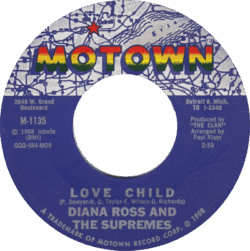This Day in Pop Music History: A Social Taboo Subject Becomes a Motown, Pop Hit Milestone On November 24, 1968 (a Sunday), Diana Ross & The Sup
This Day in Pop Music History: A Social Taboo Subject Becomes a Motown, Pop Hit Milestone
 On November 24, 1968 (a Sunday), Diana Ross & The Supremes reached a defining peak in their storied career. Their single “Love Child” claimed the No. 1 spot on the Billboard Hot 100, becoming the group’s 11th chart‑topper and boldly unseating The Beatles’ monumental “Hey Jude” after its nine‑week reign.
On November 24, 1968 (a Sunday), Diana Ross & The Supremes reached a defining peak in their storied career. Their single “Love Child” claimed the No. 1 spot on the Billboard Hot 100, becoming the group’s 11th chart‑topper and boldly unseating The Beatles’ monumental “Hey Jude” after its nine‑week reign.
More than a chart victory, this moment signaled a shift in pop music’s purpose: Motown’s polished sound embraced raw social commentary, giving voice to themes of stigma and resilience rarely heard in mainstream hits.
With “Love Child,” The Supremes proved that pop could be both irresistible and relevant — a song that carried rhythm and resonance while reflecting the turbulent spirit of 1968. It was a triumph not only for Motown but for American culture, as radio stations nationwide amplified a message that was as daring as it was unforgettable. — USA RADIO MUSEUM
______________________
Setting the Stage: America in 1968
The year 1968 was one of the most turbulent in American history. The assassinations of Martin Luther King Jr. and Robert F. Kennedy, the escalation of the Vietnam War, and widespread civil rights struggles created a climate of unrest. Pop music reflected this upheaval, with artists increasingly addressing social issues. Against this backdrop, Motown—known for polished love songs and crossover hits—took a bold step with “Love Child.”
The Supremes and Their Evolution
By late 1968, Diana Ross & The Supremes were already America’s most successful female group. With ten No. 1 singles behind them, they had defined the Motown sound with hits like “Baby Love,” “Stop! In the Name of Love,” and “You Can’t Hurry Love.” Yet their formula of romantic pop was beginning to feel out of step with the times. Berry Gordy, Motown’s visionary founder, recognized the need for reinvention.
“Love Child” was the answer. Written and produced by a team known as The Clan—R. Dean Taylor, Frank Wilson, Pam Sawyer, and Deke Richards—the song tackled the stigma of illegitimacy, a taboo subject in 1960s pop. Its lyrics gave voice to the struggles of children born outside of marriage, a reality often hidden in polite society.
Recording “Love Child”
 The track was recorded at Hitsville U.S.A. in Detroit in September 1968. Unlike earlier Supremes hits, “Love Child” carried a raw messenging in words and tone. The arrangement blended psychedelic soul with pop, driven by a tense rhythm section and strings that underscored the song’s emotional weight. Diana Ross delivered the lead vocal with a mix of vulnerability and defiance, embodying the pain and resilience of the song’s narrator.
The track was recorded at Hitsville U.S.A. in Detroit in September 1968. Unlike earlier Supremes hits, “Love Child” carried a raw messenging in words and tone. The arrangement blended psychedelic soul with pop, driven by a tense rhythm section and strings that underscored the song’s emotional weight. Diana Ross delivered the lead vocal with a mix of vulnerability and defiance, embodying the pain and resilience of the song’s narrator.
Chart Triumph
Released on September 30, 1968, “Love Child” quickly climbed the charts. On November 30, 1968 (week-ending, Saturday), it reached No. 1 on the Billboard Hot 100, holding the position for two weeks.
Importantly, it displaced The Beatles’ “Hey Jude,” which had dominated the charts for nine weeks. This was no small feat: “Hey Jude” was one of the biggest singles of the decade, and for The Supremes to knock it off the top spot underscored Motown’s power in shaping American pop culture.
“Love Child” also reached No. 2 on the R&B chart, further cementing its crossover appeal. It became the Supremes’ 11th No. 1 single, a record for a female group at the time.
Cultural Impact
The success of “Love Child” was groundbreaking. Motown had traditionally avoided overtly political or controversial themes, fearing alienation of its broad audience. Yet “Love Child” proved that socially conscious music could resonate with mainstream listeners. It opened the door for Motown artists like Marvin Gaye (“What’s Going On”) and Stevie Wonder to explore deeper themes in the years ahead.
For Diana Ross, the song marked a turning point. Her performance showcased her ability to move beyond romantic ballads into material with greater emotional and social resonance. This versatility would serve her well as she transitioned to a solo career in the 1970s.
_____________________
Spotlight: Love Child on The Ed Sullivan Show
On September 29, 1968, just as “Love Child” was released, Diana Ross & The Supremes brought the song to millions of viewers on CBS’s Ed Sullivan Show. This performance was more than entertainment — it was a cultural unveiling.
- National debut: The Supremes introduced “Love Child” to a prime-time audience, giving the song immediate visibility.
- Emotional delivery: Diana Ross’s impassioned vocals, paired with the group’s polished choreography, conveyed the urgency of the song’s message.
- Historic timing: Within weeks of this broadcast, “Love Child” surged to No. 1, knocking The Beatles’ “Hey Jude” from the top of the Billboard Hot 100.
- Legacy moment: The Ed Sullivan stage amplified Motown’s reach, proving that socially conscious pop could thrive in mainstream America.
_____________________
_____________________
Supremes vs. Beatles: A Chart Rivalry
 The fact that “Love Child” dethroned “Hey Jude” is historically significant. The Beatles were at the height of their powers in 1968, with “Hey Jude” becoming their longest-running No. 1 hit in the U.S. Yet Motown’s flagship group proved capable of challenging even the Fab Four. This was the fifth time in the 1960s that The Supremes replaced The Beatles at No. 1, a testament to their dominance.
The fact that “Love Child” dethroned “Hey Jude” is historically significant. The Beatles were at the height of their powers in 1968, with “Hey Jude” becoming their longest-running No. 1 hit in the U.S. Yet Motown’s flagship group proved capable of challenging even the Fab Four. This was the fifth time in the 1960s that The Supremes replaced The Beatles at No. 1, a testament to their dominance.
Looking Back: Supremes vs. Beatles on Billboard
• December 1964: The Supremes’ “Come See About Me” hit No. 1, replacing The Beatles’ “I Feel Fine.” This was part of their incredible run of three consecutive No. 1 singles in 1964 (“Where Did Our Love Go,” “Baby Love,” and “Come See About Me”).
• 1965: The Supremes’ “Stop! In the Name of Love” and “Back in My Arms Again” both reached No. 1. During this period, they again displaced Beatles singles from the top spot, underscoring the fierce chart rivalry between Motown’s queens and Liverpool’s Fab Four.
• 1968: Most famously, “Love Child” dethroned “Hey Jude” after its nine‑week reign, marking the Supremes’ 11th No. 1 and proving Motown’s staying power against the British Invasion.
Legacy of “Love Child”
Today, “Love Child” is remembered not only as a Supremes classic but also as a pioneering pop song that addressed real-world issues. Its success demonstrated that audiences were ready for music that reflected the complexities of life, not just romantic escapism.
The song has been covered and referenced in various contexts, and its influence can be traced in later socially conscious hits. For Motown, it was a bold statement that the label could evolve with the times. For Diana Ross & The Supremes, it was a reaffirmation of their place at the pinnacle of pop music.
Conclusion
On November 24, 1968, Diana Ross & The Supremes stood atop the American pop charts with “Love Child,” a song that blended Motown polish with raw social commentary. By knocking The Beatles’ “Hey Jude” from No. 1, they proved that Motown’s reach was global and its relevance undeniable. More than just a hit, “Love Child” was a cultural milestone—one that reflected the changing landscape of America and the growing maturity of pop music.
For the USA Radio Museum, this anniversary is a reminder of how radio carried songs like “Love Child” into homes across America, sparking conversations and shaping cultural memory. It stands as a testament to the power of music not only to entertain but also to challenge, inspire, and reflect the times — a society willing, in 1968, to confront with open awareness a subject many had long considered a whispered taboo.
_____________________
Contact: jimf.usaradiomuseum@gmail.com
_________________________
A USARM Viewing Tip: On your PC? Mouse/click over each image for expanded views. On your mobile or tablet device? Finger-tap all the above images inside the post and stretch image across your device’s screen for LARGEST digitized view. Then click your brower’s back arrow to return to the featured post.
© 2025 USA Radio Museum. All rights reserved.





